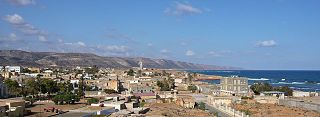
Cyrenaica or Kyrenaika, is the eastern region of Libya. Cyrenaica includes all of the eastern part of Libya between the 16th and 25th meridians east, including the Kufra District. The coastal region, also known as Pentapolis in antiquity, was part of the Roman province of Crete and Cyrenaica, later divided into Libya Pentapolis and Libya Sicca. During the Islamic period, the area came to be known as Barqa, after the city of Barca.

Berenice II Euergetis was queen regnant of Cyrenaica from 258 BC to 246 BC and co-regent queen of Ptolemaic Egypt from 246 BC to 222 BC as the wife of Ptolemy III.

Cyrene or Kyrene, was an ancient Greek and later Roman city near present-day Shahhat, Libya. It was the oldest and most important of the five Greek cities, known as the pentapolis, in the region. It gave eastern Libya the classical name Cyrenaica that it has retained to modern times. Located nearby is the ancient Necropolis of Cyrene. The traditional founder of the city was Battus the Lacedemonian, though the exact relationship between the fledgling city and other cities has led historians to question that narrative. Particularly, the idea that Thera was the sole "mother city" is disputed; and the relationship with other cities, such as Sparta and Samian merchants, is unclear.

Synesius, was a Greek bishop of Ptolemais in ancient Libya, a part of the Western Pentapolis of Cyrenaica after 410. He was born of wealthy parents at Balagrae near Cyrene between 370 and 375.

Benghazi is the second-most populous city in Libya as well as the largest city in Cyrenaica, with an estimated population of 807,250 in 2020. Located on the Gulf of Sidra in the Mediterranean, Benghazi is also a major seaport.

Ptolemais was one of the five cities that formed the Pentapolis of Cyrenaica, the others being Cyrene, Euesperides, Tauchira/Teuchira, and Apollonia.

A pentapolis is a geographic and/or institutional grouping of five cities. Cities in the ancient world probably formed such groups for political, commercial and military reasons, as happened later with the Cinque Ports in England.

Apollonia in Cyrenaica was founded by Greek colonists and became a significant commercial centre in the southern Mediterranean. It served as the harbour of Cyrene, 20 km (12 mi) to the southwest.

Barca, also called Barce, was an ancient city and former bishopric, which survives as both a Latin Catholic and an Orthodox titular see.

During the Iron Age and classical antiquity, Libya referred to North Africa. Berbers occupied the area for thousands of years before the recording of history in ancient Egypt. Climate changes affected the locations of the settlements.

This article, dealing with the Coptic Orthodox Church in Africa, is about the Coptic Orthodox Church of Alexandria in African countries other than Egypt.

Christianity is a minority religion in Libya. It has been present in Tripolitania and Cyrenaica since Roman times.

Susa or Soussa is a town and seaside resort in the District of Jabal al Akhdar in north-eastern Libya. Susa stands by the ruins of Apollonia, Cyrenaica. The town contains the Apollonia Museum. It is located about 30 km northeast of Bayda.

Olbia or Theodorias was a Roman / Byzantine town between Marj and Bayda in the Cyrenaica region of modern Libya. Olbia is now mostly the archaeological site. The location's modern name is Qasr Libya, after the Islamic period castle (Qasr) on the site and Libya or Lebia as a corruption of the ancient name Olbia.
Libya's second largest city, Benghazi, has a history which extends from when the city was first inhabited in the 6th century BCE to the present day. Throughout its history, the city has been continuously conquered by different ancient and colonial forces.

The area of North Africa which has been known as Libya since 1911 was under Roman domination between 146 BC and 672 AD. The Latin name Libya at the time referred to the continent of Africa in general. What is now coastal Libya was known as Tripolitania and Pentapolis, divided between the Africa province in the west, and Crete and Cyrenaica in the east. In 296 AD, the Emperor Diocletian separated the administration of Crete from Cyrenaica and in the latter formed the new provinces of "Upper Libya" and "Lower Libya", using the term Libya as a political state for the first time in history.
Copts in Libya may refer to people born in or residing in Libya of full or partial Coptic origin. Coptic people are an ethnoreligious group that form the largest Christian group in Libya, the Coptic Orthodox Church in the country having an estimated 60,000 adherents. The Coptic Church is known to have historical roots in Libya long before the Arabs advanced westward from Egypt into Libya. A part of the community is made up of immigrants from Egypt.
Boreum was a city and diocese in Roman Libya. It is now a Roman Catholic titular see.
Erythrum was a city and bishopric in Roman Africa, which remains a Catholic titular see.















